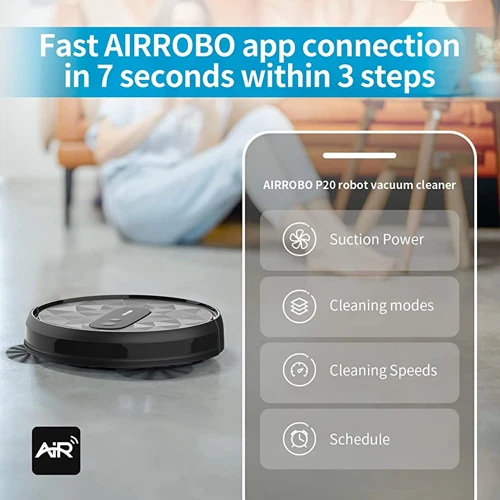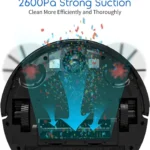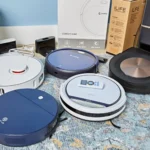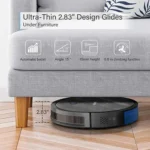Most of us have come to rely on smart vacuum cleaners to maintain a clean and healthy home without lifting a finger. However, one of the most frustrating things that can happen with these gadgets is a slow charging speed. It can be perplexing, especially when you need your smart vacuum cleaner to be ready to take care of a surprise spill, or when you have pets that shed constantly. Don’t worry, though- we’ve got you covered! In this article, we’ll help you understand the factors that affect charging speeds, give you tips on how to optimize them, and troubleshoot issues that may be causing slow charging. By the end of reading this comprehensive guide, you’ll be well equipped to get the most out of your smart vacuum cleaner!
Factors That Affect Charging Speeds

Charging speed is a crucial aspect of any smart vacuum cleaner. It determines how quickly your device will be ready for another cleaning session. However, several factors can affect charging speeds, meaning your cleaner may not always charge as quickly as you want. Understanding these factors can help you optimize charging speeds and keep your device running smoothly. In this section, we’ll explore the various factors that can impact the speed of your smart vacuum cleaner’s charging. From battery capacity to charging technology, we’ll take a closer look at the key elements that determine how fast your device will be ready to clean again. So, let’s get started!
Battery Capacity
One of the most crucial factors to consider for charging speeds of smart vacuum cleaners is the battery capacity. The battery capacity is directly proportional to the charging time of the vacuum cleaner. Typically, smart vacuum cleaners are powered by Lithium-ion batteries with varying capacities. The higher the capacity of the battery, the longer it takes to charge. On the other hand, a lower battery capacity will take much lesser time to charge.
It is essential to note that charging times can vary drastically based on the type of battery and its capacity. For instance, a 2000mAh Lithium-ion battery would take approximately 2-3 hours to charge from 0-100% using a 15-20V charger, while a 3000mAh battery would take approximately 3-4 hours using the same charger. It’s crucial to ensure that your charging dock is compatible with your vacuum cleaner battery capacity, which minimizes compatibility issues.
Depending on your smart vacuum cleaner model and battery specifications, you can choose between wall-mounted and portable chargers. Wall-mounted chargers are significantly faster as they are generally plugged into the main electrical system and directly supply power to the docking station. On the other hand, portable chargers are convenient for on-the-go users and can take more extended periods to recharge the vacuum cleaner fully.
To optimize the charging speed, always use the smart vacuum charger that comes with the product kit. Using an alternate charger may not be compatible with the vacuum cleaner’s battery, leading to compatibility issues, which can impact the charging speed.
It’s essential to note that charging a battery isn’t merely plugging it in and waiting for it to fill up. It’s not only about the battery capacity and charger compatibility, but we also need to look at a few other factors that may affect the charging speed of your vacuum cleaner.
Charging Technology
When it comes to charging technology, there are several options to choose from, each with its own strengths and weaknesses. Let’s take a closer look at the different types of charging technology that are available for smart vacuum cleaners:
1. Wall-Mounted Chargers
Wall-mounted chargers are a popular choice for many smart vacuum cleaner users. As the name suggests, these chargers are mounted on a wall, usually near an electrical outlet, and the vacuum cleaner is plugged into the charger to charge. Wall-mounted chargers can be a great space-saving option, as they keep the vacuum cleaner out of the way while it charges.
Pros:
- Space-saving
- Convenient location near power source
- Usually included with vacuum cleaner purchase
Cons:
- Can be difficult to install
- May not be suitable for all homes
- May be less portable than other charging options
If you’re considering a wall-mounted charger, be sure to check out our in-depth comparison of wall-mounted vs. portable chargers to help you make an informed decision.
2. Portable Chargers
Portable chargers are another popular option for smart vacuum cleaner users. These chargers are typically small and lightweight, making them easy to carry around and use in different rooms of the house. Portable chargers can be a great option if you have a large home or if you want the flexibility to charge your vacuum cleaner anywhere.
Pros:
- Portable and lightweight
- Can charge vacuum cleaner anywhere
- May be more versatile than wall-mounted chargers
Cons:
- May be less powerful than wall-mounted chargers
- May not be included with vacuum cleaner purchase
- May need to be purchased separately
If you’re interested in a portable charger, be sure to check out our article on the benefits of using a smart vacuum charger to make sure you’re making the right choice for your needs.
3. Compatibility Issues
It’s important to keep in mind that not all chargers are compatible with all smart vacuum cleaners. Be sure to check the specifications of your vacuum cleaner before purchasing a charger to avoid any compatibility issues. Additionally, if you’re experiencing slow charging speeds, it may be worth checking for any compatibility issues between your vacuum cleaner and your charger.
If you’re having trouble finding a compatible charger for your smart vacuum cleaner, check out our article on compatibility issues with chargers for smart vacuum cleaners to learn more.
4. Other Types of Chargers
There are several other types of chargers available for smart vacuum cleaners, including docking stations, charging bases, and more. Each type of charger has its own strengths and weaknesses, so be sure to do your research before making a purchase.
If you’re interested in learning more about the different types of chargers available for smart vacuum cleaners, check out our article on the types of chargers for smart vacuum cleaners to help you make an informed decision.
Power Output of Charging Dock
The power output of the charging dock is a critical factor in determining the charging speeds of a smart vacuum cleaner. This factor determines the amount of power that will flow from the charging dock to the smart vacuum cleaner during charging. A higher power output translates to faster charging speeds.
Different charging docks have different power outputs, which are usually expressed in watts (W). It is therefore essential to check the specifications of the charging dock before buying it to ensure that it is compatible with your smart vacuum cleaner and can provide the required power output.
The table below summarizes the power output of some popular charging docks for smart vacuum cleaners:
| Charging Dock | Power Output |
|---|---|
| Charging Dock A | 20W |
| Charging Dock B | 30W |
| Charging Dock C | 40W |
| Charging Dock D | 50W |
As seen in the table above, charging dock D provides the highest power output among the charging docks listed, and will, therefore, charge the smart vacuum cleaner faster than the others. However, it is important to note that this may come at a higher cost.
It is also important to note that the power output of the charging dock alone cannot determine the charging speed of a smart vacuum cleaner. The other factors mentioned in this article, such as battery capacity, charging technology, and operating temperature, also play significant roles.
The type of charging dock you choose can affect the charging speed of your smart vacuum cleaner. For example, a wall-mounted charger may offer a better power output than a portable charger, but it may be less convenient to use. It is essential to weigh the pros and cons of the different types of charging docks available before making a choice.
The power output of the charging dock is a crucial factor that affects the charging speed of a smart vacuum cleaner. To ensure optimal performance, it is necessary to select a compatible and high-quality charging dock that provides a sufficient power output.
Cleaner’s Energy Consumption
One of the most important factors that can affect the charging speed of smart vacuum cleaners is the amount of energy consumed by the device. To better understand how this affects charging speeds, let’s take a closer look at the energy consumption of some of the most popular models on the market.
Model | Energy Consumption (Watts)
Roomba i7+ | 33.6W
Shark IQ Robot | 25W
Eufy RoboVac 11S | 25W
Neato Botvac D7 | 40W
Ecovacs Deebot Ozmo 930 | 30W
As you can see from the table above, there is a significant difference in energy consumption between different models of smart vacuum cleaners. This can have a big impact on the amount of time it takes for a device to fully charge.
If you’ve noticed that your smart vacuum cleaner is taking longer than usual to charge, it’s worth checking the device’s energy consumption levels. If your device is consuming more energy than usual, it could be a sign of a problem with the vacuum cleaner itself. In this case, it’s best to contact the manufacturer for advice.
On the other hand, if you notice that your smart vacuum cleaner is consuming less energy than usual, this could be a sign that the device is not functioning at full capacity. This could be due to a number of factors, including dirty charging contacts or compatibility issues with the charging dock.
To ensure that your smart vacuum cleaner is functioning at optimal efficiency, it’s important to keep a close eye on its energy consumption levels. Regularly cleaning the device and its charging contacts, and ensuring that it is compatible with the charging dock, can help to maintain optimal energy consumption levels.
For more information on smart vacuum chargers and compatibility issues, check out our articles on smart vacuum chargers and compatibility issues with smart vacuum cleaners. You can also learn more about the different types of chargers available for smart vacuum cleaners in our article on types of chargers for smart vacuum cleaners.
Operating Temperature
The operating temperature is another important factor that affects the charging speeds of a smart vacuum cleaner. Temperature affects the ability of the battery to store energy and how efficiently it can absorb it.
In general, the optimal operating temperature range for most rechargeable batteries is between 32°F to 113°F (0°C to 45°C). If the battery gets too hot or too cold, the charging speed can be reduced, and the battery life can be affected.
Extreme temperatures can also cause irreversible damage to the battery, reducing its overall lifespan. It is important to keep the operating temperature of the vacuum cleaner within this desirable range.
Below is a table that shows the effects of different temperature ranges on battery performance:
| Temperature Range | Effect on Battery Performance |
|---|---|
| Below 32°F (0°C) | Battery capacity may decrease, and charging time may increase. |
| 32°F to 59°F (0°C to 15°C) | The battery may take longer to charge. |
| 59°F to 86°F (15°C to 30°C) | The ideal temperature range for most rechargeable batteries. Optimal charging speeds and battery life can be expected. |
| Above 86°F (30°C) | Battery capacity may decrease, and charging time may increase. Overheating can also cause permanent damage to the battery. |
It is worth noting that temperature can also affect the charging dock and the vacuum cleaner’s charging circuitry. If the charging circuitry gets too hot, it can cause charging to slow down or even stop altogether. On the other hand, if the circuitry gets too cold, it can affect the efficiency of the charging process.
To optimize charging speeds, it is recommended to keep the vacuum cleaner and its charging dock in a temperature-controlled environment. Avoid exposing the unit to direct sunlight or extreme temperatures, which can affect charging performance and reduce the vacuum cleaner’s overall battery life.
How to Optimize Charging Speeds
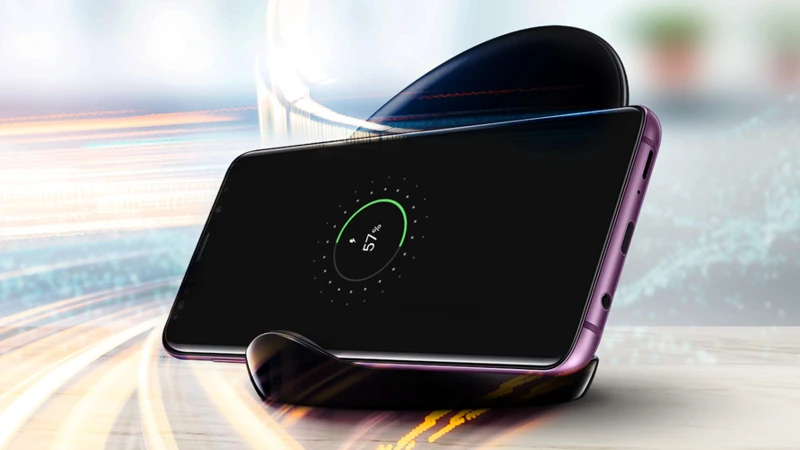
Are you tired of constantly waiting for your smart vacuum cleaner to charge? It can be frustrating to have to interrupt your cleaning routine midway because of low battery life. Luckily, there are several ways you can optimize your charging speeds and ensure that your vacuum cleaner has enough power to clean your home thoroughly. Let’s dive into some strategies for maximizing your vacuum cleaner’s charging speed, so you can make the most of your cleaning time.
Charge Vacuum Cleaner Overnight
One of the easiest and most effective ways to optimize the charging speed of your smart vacuum cleaner is to charge it overnight. This allows the vacuum cleaner to fully charge when it is not in use, so that it is ready for use at any time during the day.
Benefits of charging overnight
Charging overnight has several benefits, including:
| Benefits | Explanation |
|---|---|
| Full Charge | Charging overnight ensures your vacuum cleaner is fully charged, saving you time and hassle |
| Convenience | You can start a cleaning cycle at any time of the day without worrying about charging |
| Longer battery life | Charging overnight helps to extend the life of your vacuum cleaner’s battery |
Charging time
The charging time for your smart vacuum cleaner will depend on the factors that affect charging speeds, such as battery capacity and charging technology. However, most smart vacuum cleaners take around 2-4 hours to fully charge.
Tips for charging overnight
To ensure that you get the most out of charging overnight, follow these tips:
| Tips | Explanation |
|---|---|
| Ensure the docking station is plugged in | Make sure the docking station is plugged in and turned on to ensure your vacuum cleaner charges overnight |
| Place the docking station in a convenient location | Place the docking station in a location that is easy to access, so you can quickly dock your vacuum cleaner when you are finished using it |
| Clean the charging contacts regularly | Ensure the charging contacts on both the vacuum cleaner and the docking station are clean to avoid any charging issues |
By following these tips and charging your smart vacuum cleaner overnight, you can ensure that it is always charged and ready to clean whenever you need it.
Clean the Docking Station and Vacuum Cleaner’s Contacts Regularly
Maintaining a clean docking station and vacuum cleaner contacts is crucial to ensure optimal charging speeds. Dirt and debris can accumulate over time, hindering the proper connection between the two, resulting in slower charging speeds. Here are some steps to follow for proper cleaning:
- Disconnect the Vacuum Cleaner: Before cleaning, make sure to disconnect the vacuum cleaner from the docking station to avoid electrical hazards.
- Clean the Docking Station: Using a soft, dry cloth, wipe the surface of the docking station to remove any dust or debris. For tougher stains or dirt buildup, use a damp cloth or a gentle cleanser. Be careful to avoid getting any liquid inside the docking station, as it can damage the charger.
- Clean the Vacuum Cleaner’s Contacts: Using a dry cotton swab or soft, dry cloth, gently wipe the metal contact points on the vacuum cleaner. Be sure to remove any dirt or debris that may have accumulated on these contact points.
- Inspect for Damage: While cleaning, check the contacts for any signs of damage, such as cracks or discoloration. If you notice any damage, or if the contacts appear to be corroded, it may be time to replace the docking station or contact the manufacturer for assistance.
Regularly cleaning the docking station and vacuum cleaner contacts can help ensure proper connection and optimal charging speeds, extending the life of your smart vacuum cleaner.
Place the Docking Station in a Convenient Location
The placement of the docking station can have a significant impact on the charging speeds of your smart vacuum cleaner. To optimize your vacuum cleaner’s charging speed, you should strategically place the docking station in a location that is convenient and accessible.
Here are some tips for placing the docking station in the optimal location:
- Avoid placing the docking station in cramped or hard-to-reach areas. Placing the docking station in an area that is difficult to access or navigate can slow down the process of docking and charging your smart vacuum cleaner. It is important to choose a spot that is easily accessible and has enough space for the vacuum cleaner to dock comfortably.
- Choose a location that is close to the center of the room or the main living area. By placing the docking station in a central location, you can reduce the distance your vacuum cleaner needs to travel to reach it. This will not only speed up the docking process, but it can also help your vacuum cleaner navigate more efficiently around the room.
- Avoid placing the docking station near sources of heat or direct sunlight. High temperatures can negatively affect the performance of your smart vacuum cleaner’s battery and slow down the charging process. You should choose a location that is cool and away from direct sunlight or heat sources.
- Keep the docking station away from other electronics. Placing the docking station near other electronics, such as routers or televisions, can cause interference and slow down the charging process. It is best to place the docking station away from other electronics to avoid any potential interference.
- Make sure the docking station is located near a power outlet. Your docking station needs to be plugged into a power outlet to charge your smart vacuum cleaner. It is important to choose a location that is near a power outlet to avoid the need for extension cords or long power cables.
By following these tips, you can optimize your smart vacuum cleaner’s charging speed by placing the docking station in the most convenient and accessible location possible.
Run Thorough Cleaning Cycles before Charging
Before charging your smart vacuum cleaner, it is advisable to run thorough cleaning cycles. This will not only ensure that your vacuum cleaner is clean and ready for its next cleaning task, but it will also help optimize the charging speed. Here are some steps to follow when running thorough cleaning cycles:
- Clear any debris: Inspect the vacuum cleaner’s brush roll, suction inlet, and filter to make sure they are free of debris. Any debris, such as hair or dirt, can block the vacuum cleaner’s airways and reduce its suction power. This can lead to longer cleaning times and increased energy consumption, which in turn can reduce the charging speed.
- Clean the filter: The vacuum cleaner’s filter should be cleaned or replaced regularly to ensure optimal performance. A clogged filter can obstruct airflow and reduce the vacuum cleaner’s suction power. This can result in longer cleaning times and increased energy consumption, leading to slower charging speeds. Follow the manufacturer’s instructions on how to clean or replace the filter.
- Clean the brush roll: The vacuum cleaner’s brush roll can easily become tangled with hair and threads, reducing its ability to pick up dirt and debris. This can cause longer cleaning times and increased energy consumption, leading to slower charging speeds. Use scissors or a brush to gently remove any tangled debris from the brush roll.
- Clear the suction inlet: Use a small tool, such as a toothbrush or a small brush, to clear any debris from the suction inlet. This will ensure that the vacuum cleaner’s suction power is not affected, leading to shorter cleaning times and reduced energy consumption.
Running a thorough cleaning cycle before charging your smart vacuum cleaner will help optimize its performance and charging speed. By ensuring that your vacuum cleaner is clean and free of obstructions, you can reduce its energy consumption and increase its charging speed.
Check for Compatibility between Vacuum Cleaner and Charging Dock
Ensuring compatibility between your vacuum cleaner and charging dock is crucial to optimizing charging speeds. Using a mismatched dock or charger can not only result in slow charging speeds but can also damage your vacuum cleaner’s battery.
To avoid such issues, it’s necessary to check the compatibility of your vacuum cleaner and its charging dock before purchasing. This can usually be found in the product manual or specifications sheet. It’s essential to cross-check these details to ensure that the voltage and amperage output between the two devices match.
It’s also a good idea to consider purchasing the charging dock designed specifically for your vacuum cleaner. These charging docks are designed to provide optimal charging speeds while also protecting your vacuum cleaner’s battery from overcharging or overheating. Many manufacturers offer charging docks as an accessory or bundled in with the vacuum cleaner.
To make things easier, we’ve put together a compatibility table based on the popular smart vacuum cleaners and their charging docks. This table will help you easily identify the compatible charging docks for your vacuum cleaner, making the purchasing process much more convenient.
| Vacuum Cleaner | Charging Dock |
|---|---|
| Roomba i7 | Roomba i7 Charging Dock |
| Xiaomi Mi Robot Vacuum | Xiaomi Mi Robot Vacuum Charging Dock |
| Eufy Robovac 11S | Eufy Robovac 11S Charging Base |
| Shark IQ Robot | Shark IQ Robot Charging Base |
By checking for compatibility between your vacuum cleaner and its charging dock, you can ensure that your device charges efficiently and effectively, leading to speedy cleaning sessions and less downtime.
Invest in a High-Quality Charging Dock
When it comes to owning a smart vacuum cleaner, investing in a high-quality charging dock is a must if you want to optimize charging speeds. Here are some reasons why:
- Better charging technology: High-quality charging docks come with the latest charging technologies that can charge your vacuum cleaner faster and more efficiently. These technologies include features like adaptive charging, which adjusts the charging speed based on the battery’s current state, and optimized heat management, which prevents the battery from overheating during charging.
- Built-in safety features: A high-quality charging dock is likely to come with built-in safety features such as surge protection, voltage protection, and short-circuit protection. These features prevent your vacuum cleaner’s battery from getting damaged during charging, which can cause slower charging speeds and even permanent damage to the battery over time.
- Durable construction: Investing in a high-quality charging dock means you’re likely to get a device that is built to last. This prevents the need for constant replacements, which can be costly and time-consuming.
- Compatibility: A high-quality charging dock is designed to work specifically with your smart vacuum cleaner, so you can be sure that your vacuum is getting the right amount of power and the right charging speed.
- Warranty: Most high-quality charging docks come with a warranty, which ensures that any defects or issues with the device can be resolved without any extra cost to you. This is especially important as charging docks can be a significant investment.
Investing in a high-quality charging dock is crucial if you want to get the most out of your smart vacuum cleaner, and it’s a decision that can ultimately save you time, money, and hassle in the long run. So, be sure to do your research, read reviews, and choose a charging dock that is the right fit for your vacuum cleaner’s needs.
How to Troubleshoot Slow Charging Speeds
Are you experiencing disappointingly slow charging speeds with your smart vacuum cleaner? If so, don’t worry. There are several steps you can take to troubleshoot the issue and get your device charging at full speed again. From checking your power outlet and cleaning the charging contacts to moving the docking station to a cooler location and checking for firmware upgrades, there are a variety of potential solutions to try. In this section, we’ll explore these troubleshooting tips in detail, so you can keep your smart vacuum cleaner charged and ready to go when you need it.
Check the Power Outlet and Power Cord
When it comes to troubleshooting slow charging speeds for your smart vacuum cleaner, checking the power outlet and power cord is one of the first steps you should take. It may seem obvious, but many people overlook this simple solution. Here are some steps to follow:
- Check the power outlet. Make sure the outlet you’re using is functioning properly. You can test it by unplugging your vacuum cleaner and plugging in another appliance, like a lamp or phone charger. If the other device doesn’t work, then the outlet may be the problem.
- Check the power cord. If the outlet is working properly, then check the power cord for any damage. Look for frayed wires, cuts or tears in the insulation, or discoloration. If you see any of these signs, then the power cord may need to be replaced.
- Check for loose connections. Make sure the power cord is securely plugged into both the vacuum cleaner and the power outlet. Sometimes, a loose connection can cause slow charging speeds or prevent the vacuum cleaner from charging altogether.
By following these simple steps, you can identify and fix any issues with the power outlet or power cord that may be slowing down your vacuum cleaner’s charging speed. If the issue persists, then it may be time to consider other factors that could be affecting the charging speed, such as the energy consumption of the cleaner, the power output of the docking station, or the operating temperature.
Clean the Charging Contacts
Keeping the charging contacts of your smart vacuum cleaner and docking station clean is crucial for optimizing charging speeds. Over time, dirt and debris can accumulate on the charging contacts, which can disrupt the flow of energy and slow down the charging process.
To clean the charging contacts, follow these simple steps:
Step 1: Unplug your smart vacuum cleaner and remove it from the docking station.
Step 2: Use a dry microfiber cloth to gently wipe both the charging contacts on the vacuum cleaner and the contacts on the docking station. Be sure to remove any dust, dirt or debris that may have accumulated.
Step 3: If the charging contacts are particularly dirty or if there is a greasy film on them, dampen the microfiber cloth with a small amount of rubbing alcohol or vinegar.
Step 4: Use a cotton swab to clean any hard-to-reach areas around the charging contacts.
Step 5: Once the contacts are clean, let them air dry completely before placing the vacuum cleaner back on the docking station to charge.
By regularly cleaning the charging contacts of your smart vacuum cleaner and docking station, you can ensure that the energy flow remains constant and uninterrupted, which will help optimize the charging speeds.
Move Docking Station to a Cooler Location
One factor that can significantly affect the charging speed of your smart vacuum cleaner is the operating temperature. A charging dock that is located in a hot room or directly under sunlight may cause the battery to overheat, which can lead to slower charging speeds and even permanent damage to the battery’s performance.
To optimize the charging speed and protect the battery of your vacuum cleaner, consider moving the docking station to a cooler location. This not only allows for faster charging times, but also extends the lifespan of your vacuum cleaner’s battery.
Here are a few tips on where to place your docking station:
| Location | Advantage |
| In a cool and well-ventilated room | Avoids overheating and allows for optimal charging |
| Close to the power outlet | Minimizes power loss and potential interruptions in charging |
| On a stable and level surface | Avoids accidental falls or damage to both the cleaner and the docking station |
| Away from water and other liquids | Prevents damage to the cleaner’s electrical components and the battery |
By following these simple tips, you can help ensure that your smart vacuum cleaner charges efficiently and for a longer lifespan.
Check for Firmware Upgrades
Keeping your smart vacuum cleaner’s firmware up-to-date is essential for optimal performance. Firmware upgrades can improve your vacuum cleaner’s charging speed as well as provide new features and bug fixes. Here are some steps to follow to ensure your vacuum cleaner’s firmware is up-to-date:
- Check the Manufacturer’s Website: Visit the manufacturer’s website and look for firmware upgrades or updates for your specific model. Most manufacturers will have a support section on their website where you can find firmware upgrades for their products.
- Read the Release Notes: Before downloading any firmware update, read the release notes carefully. The release notes will detail the changes and improvements that the firmware upgrade will bring. It is important to make sure the firmware upgrade will address the specific issue you are experiencing with slow charging speeds.
- Follow the Manufacturer’s Instructions: Follow the instructions provided by the manufacturer to install the firmware upgrade. Installing firmware upgrades can be a delicate process, so it is important to follow the instructions exactly to avoid any damage to your vacuum cleaner.
- Reset the Vacuum Cleaner: After installing the firmware upgrade, reset your vacuum cleaner. This will help to ensure that the new firmware is properly installed and all the settings are properly configured. The reset process will vary depending on the model of vacuum cleaner, so refer to the user manual for instructions.
By following these steps, you can ensure that your smart vacuum cleaner’s firmware is up-to-date, and you are getting the fastest possible charging speeds. Remember, checking for firmware upgrades is just one of the steps you can take to optimize your vacuum cleaner’s charging speed. By combining this step with the other steps outlined in this article, you can ensure your vacuum cleaner is always ready to clean your home efficiently and effectively.
Conclusion
After going through this comprehensive guide on understanding charging speeds for smart vacuum cleaners, it should be clear that various factors can affect the charging speed of your device. From the battery capacity and charging technology to the cleaner’s energy consumption and operating temperature, there are many things to consider when looking to optimize and troubleshoot charging speeds.
To ensure you get the most out of your smart vacuum cleaner, it’s important to follow the steps outlined in this guide to optimize your charging speed. Charging your vacuum cleaner overnight, cleaning the docking station and vacuum cleaner’s contacts regularly, placing the docking station in a convenient location, running thorough cleaning cycles before charging, checking for compatibility between your vacuum cleaner and charging dock, and investing in a high-quality charging dock are all ways to improve your device’s charging speed.
However, even with these optimization techniques, it’s possible to experience slow charging speeds that may need troubleshooting. Checking the power outlet and power cord, cleaning the charging contacts, moving the docking station to a cooler location, and checking for firmware upgrades are all possible solutions to these issues.
In conclusion, understanding the factors that affect charging speeds for smart vacuum cleaners and staying on top of optimization and troubleshooting methods will go a long way in ensuring your device is always running at optimal performance. By implementing the steps discussed in this guide, you will be able to keep your smart vacuum cleaner fully charged and ready to tackle any cleaning task at hand.
Frequently Asked Questions
What is the average charging time for a smart vacuum cleaner?
The average charging time for a smart vacuum cleaner is around 2 to 4 hours.
Can charging a smart vacuum cleaner overnight damage the battery?
No, charging a smart vacuum cleaner overnight will not damage the battery as long as it is compatible with the charging dock.
What factors can affect the charging speed of a smart vacuum cleaner?
Factors that can affect the charging speed of a smart vacuum cleaner are battery capacity, charging technology, power output of charging dock, cleaner’s energy consumption, and operating temperature.
How can I optimize the charging speed of my smart vacuum cleaner?
You can optimize the charging speed of your smart vacuum cleaner by charging it overnight, cleaning the docking station and vacuum cleaner’s contacts regularly, placing the docking station in a convenient location, running thorough cleaning cycles before charging, checking for compatibility between vacuum cleaner and charging dock, and investing in a high-quality charging dock.
What should I do if my smart vacuum cleaner is charging slowly?
If your smart vacuum cleaner is charging slowly, you should check the power outlet and power cord, clean the charging contacts, move the docking station to a cooler location, and check for firmware upgrades.
What is the best location to place the docking station for my smart vacuum cleaner?
The best location to place the docking station for your smart vacuum cleaner is in a convenient location that is easily accessible and has good air circulation.
Can I use a charging dock from a different manufacturer for my smart vacuum cleaner?
No, it is not recommended to use a charging dock from a different manufacturer for your smart vacuum cleaner as it may not be compatible and can cause damage to both the vacuum cleaner and the charging dock.
How often should I clean the docking station and vacuum cleaner’s contacts?
You should clean the docking station and vacuum cleaner’s contacts at least once a month to maintain optimal charging speed and prevent charging issues.
How can I tell if my smart vacuum cleaner is compatible with a charging dock?
You can check the product specifications of your smart vacuum cleaner and the charging dock to see if they are compatible. It is always best to use the recommended charging dock from the manufacturer.
Should I charge my smart vacuum cleaner after every use?
No, it is not necessary to charge your smart vacuum cleaner after every use. It is best to wait until the battery is low before charging to maintain optimal battery life.
